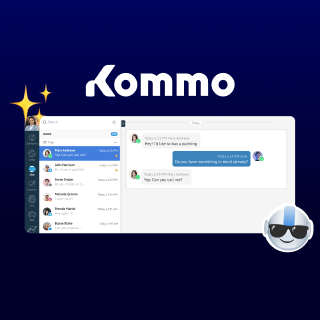Integrations
Personal integration are used to make an improvement for only one account, to add a feature that only one company/account needs.
If you are developing a Marketplace integration, you can get started here, and then come back for the widget structure, since it’s the same for all integrations types.
Any integration must be registered in an account in order to receive keys for OAuth authorization, as there can be no anonymous API calls. The client must understand which services have access to account data and to what extent.
Kommo account
To develop a personal integration; it will be enough to register an account on our website kommo.com. You can use an account with a trial version or your own business account.
Accounts parameters are just two!
| Parameter | Example |
| User email | developer@example.com |
| Account address | subdomain.kommo.com |
Now when we have an account, let’s look at how an integration can affect it!
Capabilites
Personal integrations can have a widget which can work with the following capabilities
| Capability | Description |
| Kommo API | The ability to manipulate and generate data in Kommo including account, users, leads, contacts, tasks, etc. |
| JS SDK | Set of functions and objects that facilitate accessing the environment (information about the widget, the authorized user, etc.), as well as for calling some interface elements. |
| Salesbot | A tool for creating custom scenarios to automate operations with a user via messengers. |
| Digital pipeline | A powerfull automation tool that allows you to set up reactions to different events such as incoming emails, calls or messages, lead stage change or website visit |
| Chat API | The ability to create integration with different messengers and enable Kommo users to send and recieve messages through it |
| VoIP API | Set of API and JS methods that are useful to connect telephony services with Kommo. |
Finally, you can easily spread your solution to new accounts by creating a new personal integration in them and manually uploading the same widget to it.
The development of a personal integration
This integration type is characterized by being fast and can be developed under any kind of account. Feel free to use your business account or a technical account for development.
Personal integrations don’t pass any moderation!
The first step is to go to Settings, Integrations of the account, in which you will support the integration in the future.
Settings -> Integrations -> Create Integration in Kommo accounts
Settings -> Integrations -> Create Integration -> Personal in technical accounts.
After clicking on the Create Integration button, a form appears containing the integration properties.
Integration Properties:
- The name of the integration (no more than 255 characters) is displayed on the integration page, a modal window for granting access, and also participates in the search on the integration page.
- Integration description (no more than 65,000 characters) is displayed in the modal integration window in the user account. It is allowed to use HTML layout.
- The redirect link is a link to your site that will handle the work with keys. It is important that the domain must be protected by an SSL certificate if you plan to use integration in more than one account. We also periodically check the availability of the domain as a prerequisite for the integration to work.
- Link for a hook about disabling integration. A GET request will be sent to this address when the user disables integration. The request will contain two parameters: account_id and client_id. The field for the disconnect hook is optional.
- Grant access is the minimum set of necessary permissions for integration to work. You can read more about permissions in the scopes.
- Integration icon (400×272) (jpeg/jpg/png/gif) is displayed in the list of integrations and in the window for getting access from the user.
- Duplicate control: you need to check this box if your integration supports Duplicate Control.
- Multiple sources: you need to check this box if your integration manages the sources itself via the Sources API. If the checkbox is set, Kommo will not create sources by default; the integration itself will have to create all the sources it needs.

As you noticed, you can upload a widget to the integration. An integration without a widget can be used just to get the keys needed for accessing the API, but the widget is the part that holds the programming details.
After filling out the form, save the integration. Kommo will generate and show the necessary keys in the Keys and scopes tab. The authorization code you can use in the authorization process, Secret key and Integration ID will be used independently from the account in which it will be installed. If you upload a widget, a Widget code will be created.

After this point, you should work on authorizing the integration in Kommo API and developing the functions you need. See our step-by-step example to start it.
Download the sample widget
You can download it from here.
If you are developing a marketplace integration, jump to the getting started with marketplace integration.
Next, let’s see the Structure of a widget.


